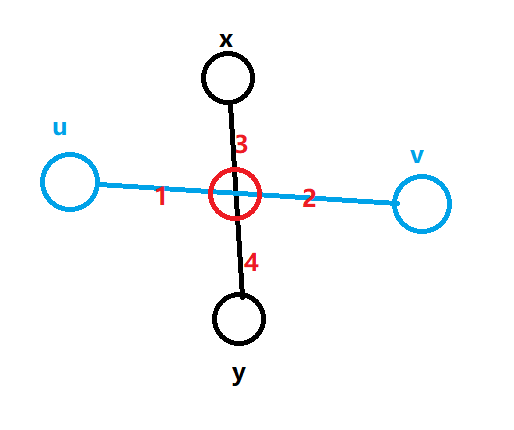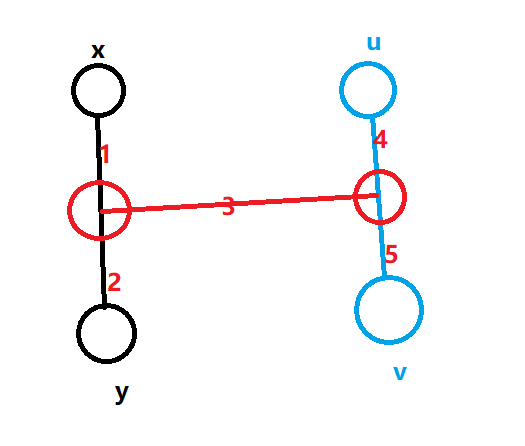证明
求树的直径的方法:
- 选择树上任意一点,从该点dfs,求其它所有点到x的距离distx[]
- 从distx[]中选择一个最大的距离所对应的点y,从y开始再次dfs求一个disty[]
- disty[]中的最大值就是树的直径
求树的直径的bfs/dfs方法的正确性证明:
问题就在第一点:距离x最远的y点在树的直径上。
现在证明这个结论
反正法:
假设y不在直径上,那么有以下情况:
- 树的直径和(x -> y)的路径存在交点。

此时(u -> v)为树的直径
而(dist(x, y) ge dist(x, u))它们存在公共部分(3), 所以有(1 le 4)
从而(1 + 2 le 4 + 2), 所以有(dist(u, v) le dist(y, v))
那么(dist(y, v))就成了直径,(y)成了直径的端点,与假设矛盾。
- 树的直径和(x -> y)的路径不存在交点。

此时(u -> v)
为树的直径
因为(dist(x, y) ge dist(x, v))
所以有(1 + 3 + 5 le 1 + 2)
( o 3 + 5 le 2)
( o 2 + 3 ge 5)
( o 2 + 3 + 4 ge 5 + 4)
( o dist(y, u) ge dist(u, v))
所以(dist(y, u))为树的直径,所以(y)为树的直径上的端点,与假设矛盾。
综上,结论“距离x最远的y点在树的直径上”结论获证。
代码
#include<iostream>
#include<cstring>
using namespace std;
const int N = 100010, M = 200010;
int h[N], e[M], ne[M], w[M], idx;
int n;
int dist[N], st[N];
int add(int a, int b, int c){
e[idx] = b, ne[idx] = h[a], w[idx] = c, h[a] = idx ++;
}
void dfs(int u){
for(int i = h[u]; ~i; i = ne[i]){
int j = e[i];
if(st[j]) continue;
st[j] = 1;
dist[j] = dist[u] + w[i];
dfs(j);
}
}
int main(){
memset(h, -1, sizeof h);
cin >> n;
for(int i = 1; i < n; i ++){
int a, b, c;
cin >> a >> b >> c;
add(a, b, c);
add(b, a, c);
}
st[1] = 1;
dfs(1);
int k = 1;
for(int i = 2, maxv = dist[1]; i <= n; i ++)
if(maxv < dist[i]){
maxv = dist[i];
k = i;
}
memset(st, 0, sizeof st);
st[k] = 1;
dist[k] = 0;
dfs(k);
int res = dist[1];
for(int i = 2; i <= n; i ++)
res = max(res, dist[i]);
cout << res << endl;
}